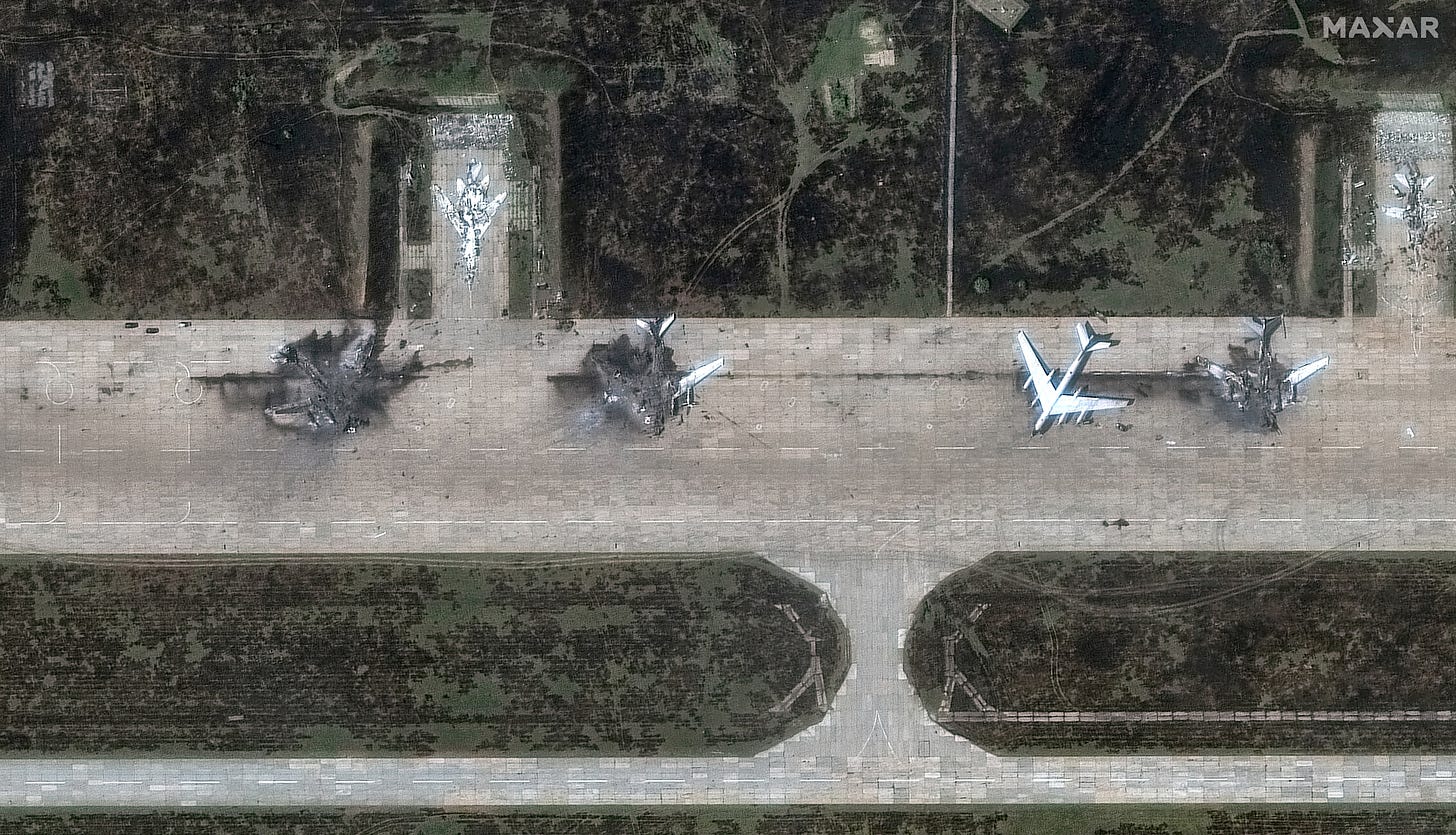Drones will realize the promise of suicide terrorism
Yesterday, Mossad used smuggled explosive drones to assassinate the commander-in-chief of Iran’s Islamic Revolutionary Guard Corps (IRGC), the chief of staff of the Iranian Armed Forces, the entire IRGC Air Force senior staff, and several top nuclear scientists in a surprise attack.
Given the hundreds of Israeli sorties flying uncontested in Iranian airspace in the last 24 hours, the drone attacks appear to have completely neutralized Iran’s air defenses.
Two weeks prior (June 1), the Ukrainian domestic intelligence service (SBU) struck five Russian airbases across a distance of 3,000 miles in a smaller attack, inflicting billions of dollars in damage on a strategic bomber fleet that will take years, if not decades, to replace.
Like 9/11 or Lashkar-e-Taiba’s 2008 Mumbai terror raid, Ukraine’s attack was symbolic and mediagenic — they deliberately chose hard targets, at a scale and distance that mandated extremely sophisticated planning, coordination, and secrecy. The intent was at least as much about demonstrating Ukraine’s strike capability as it was about degrading Russia’s.
These attacks now force military planners all over the world to look over their shoulders, treating all civilian vehicles as potential threats in their own country — introducing massive new psychological and logistical costs in the same way that the Israeli pager bombings did.
But the self-conscious exquisiteness and surprise of these attacks almost obscures their consequences, because the next hit doesn’t need to be anywhere near as skillful.
[What follows is a personal anecdote I heard at a dinner party. I have no ability to verify any of the details.]
Years ago, a friend of mine attended a terrorism red-team seminar, where some military novelists and think-tank types were invited to dream up terror attacks (apparently DoD does this).
The worst thing they came up with was “any premeditated violence on a highway during rush hour.”
A roadside IED, or even just a guy on the back of a bike firing into traffic — or, first one and then the other.
Disabled vehicles and drivers colliding at speed immediately create a kill-box full of helpless and immobilized targets behind the attackers, and a clear getaway path ahead of them.
While the direct damage would be modest, the real money would be in the “immune response” — the economic paralysis of trying to secure countless miles of interstate in every major city.
In a hyper-mobile, distributed global economy, you can destroy billions of dollars in value just by reducing the speed at which goods and people can securely travel.
An attack of this kind requires no new technology, minimal funding, and can have devastating consequences even if not terribly well-planned — it’s essentially just “a school shooting on the freeway”.
Even if a low-powered attack failed to destroy a piece of vital infrastructure like a bridge or overpass, the need to shut a major artery down, inspect the damage, and assess repairs could impose hundreds of millions of dollars in economic disruption.
America’s defense apparatus (and, by extension, the “liberal world order” itself) is built around standoff capability.
We build no defensive fortifications tougher than a razor-wire fence (pace a handful of exceptions like NORAD) because, for the last hundred years, the dominant defense paradigm has featured massive returns to scale.
The biggest and wealthiest countries enjoyed “full spectrum dominance”: smaller and poorer players could not hope to compete with tanks and ICBMs and aircraft carriers.
We could strike a hostile actor from the other side of the planet before they could coalesce into a threat — so the vast majority of the world’s territory went uncontested and undefended.
The open sprawl of the global economy is built around this paradigm of security, and would not be possible without it.
In the aftermath of 9/11, both terrorists and counter-terrorism analysts warned of bombing campaigns against civilian “soft targets” which might overturn that paradigm — providing small players (“rogue states”, terrorists, cartels) with the means to jam the global economy, forcing incumbents to adopt unsustainably costly and invasive defensive interventions (checkpoints, armed escorts, ubiquitous fortification).
From the terrorists’ perspective, this was to be totally unanswerable within the envelope of global liberal capitalism — the killing stroke that would bring down the Great Satan.
But the threat of soft-target suicide terrorism never came to much, because a suicide bomber is a targeting system with an ego.
Terrorist handlers struggled to persuade young men to take the risk to disrupt unsexy, low-profile targets — especially once the Arab Spring made jihadi tourism more attractive.
This narrowed the aperture of what needed protecting, so that counter-terrorism authorities could focus resources on securing high-profile, symbolic sites, and surveilling the group chats where Islamists egg each other on.
Eventually terror bombings in the West became geopolitically irrelevant. (They still happen, but they don’t motivate policy, except to drive radicalization against immigrants in Europe.)
But a drone is a suicide bomber without the expensive bottleneck in targeting.
Partly that means you get a lot more shots-on-goal against conventional suicide-bomber targets (symbolic landmarks, military bases, etc.) — which is how these drones have been used by the Israelis and Ukrainians over the last two weeks.
Far more important, though, is the capacity to spam boring targets — hills that even a suicide bomber won’t die on. A commuter overpass, a power transformer, a water treatment facility, a railyard.
It will be expensive, but Russia can change some security protocols and harden its airbases. Both sides of the Ukraine War have demonstrated credible counters to drone operations against recognized military targets.
What the Russians can’t do is harden every mile of highway, every bridge, every dam. Neither can the United States, and — critically — neither can the Chinese.
Soft-target drone warfare will transform the global political order as profoundly as the stirrup or gunpowder.
The 20th century world was carved up between two gigascaled superpowers, and finally conquered by one, because there were insurmountable returns to scale: only the biggest boys could field ICBMs, satellites, cruise missiles, fighter jets, mass-media infrastructure, etc. — and those big expensive weapons systems were utterly dominant.
But a $500 drone destroying a hangar full of $150 million supersonic nuclear bombers is an existential threat to that whole geopolitical architecture.
Balaji Srinivasan argues that China will dominate in drone warfare because they have the manufacturing capacity. If drones are the winning tech, then the player that can build the most drones will inevitably win.
But, just like the stirrup, drones have created a new equilibrium in which highly advanced and industrialized societies are fundamentally vulnerable for reasons that have nothing to do with output.
The Song Dynasty had far more men and much greater production capacity than the Mongols, but it didn’t matter, because it simply wasn’t a question of manufacturing more stirrups, or raising more horses and horsemen. The new technology fundamentally altered the returns to scale in defense.
Likewise, a drone factory is as vulnerable to drone attack as any other big, static, expensive piece of defense infrastructure.
We can credibly control nukes because enriched nuclear material has few deniable civilian applications.
But drone technology is too cheap, too modular, and with too many useful civilian applications for the big players to control their manufacture.
What would you restrict, if you wanted to prevent any other actor from building drones? Batteries? Rotors? 3D printers? $17 Raspberry Pis?
Even if the Chinese embargoed all electronics manufacture to the whole planet and the Raspberry Pi cost you 100X more to produce natively, that still means state-actor force projection capability for the cost of a gaming laptop.
The Westphalian order is already in the process of collapse for other reasons — but drone tech will also upend the dominance of big exquisite military systems on which that order depends.
So what structures will be most adaptive under the new conditions?
The monopoly on violence at scale will simply be much weaker, and the scope of defensible infrastructure much smaller.
This means that there won’t be one Big Winner stepping into America’s place.
Collective security as an “industry” (i.e. the business model of statehood, the service states provide) — will no longer take the form of colossal networked managerial bureaucracies. Those will no longer be defensible, and neither will the defense products that made them dominant.
An adaptive state will look less like a multinational logistics corporation, and more like a classic “small business” — inherently fragmented by technology, deeply personal/reputational, and with low barriers to entry.
In fact, until some as-yet-unknown countermeasure is developed, it’s entirely possible that the equilibrium is “we blow up the global-scaled manufacturing apparatus with cheap drones until the drones aren’t cheap anymore.”
Drones probably won’t do all of this alone — but we are receding from a historically anomalous high water mark in the returns to scale across all domains.
Crypto now provides individuals with state-level capacity to secure and transmit capital, weakening sovereign control of capital markets. Social media has shattered sovereign capacity to dictate narrative through broadcast media. AI and the global expansion of the internet are jamming all large-scale information networks with oceans of slop.
Big players have fewer levers of power that are exclusively their own, and a growing set of physical and cognitive vulnerabilities that smaller, more nimble players don’t have to worry about.
The Pax Americana is not the end of history. It will be remembered as an unusual but easily explainable artifact of technological scale.
The future will be more like the past.
As the scale of effective communication, transportation, maintenance, and influence recedes, society will become more human and more personal, with weaker and multifarious institutions.
The collapsing institutional monopoly on violence will yield a renewal of local and personal violence, and a very messy working-out of a hierarchy suited to the new conditions.
Anyway, it’s a great time to make friends.
EXIT News
I am in Salt Lake City with my family until 6/16, doing a lot of picnics, looking to connect with the EXIT guys and their families. My itinerary is posted in the #utah channel, feel free to drop in on whatever we’re doing.
Weekly Group Calls
This Tuesday (6/10) we discussed the LA riots and family preparedness.
On 6/17, we will have a showcase of the Tech and AI call.
On 6/24, we will discuss content creation and publishing with a round-table discussion from EXIT members who have experience in traditional and independent publishing.
Our Great Houses call is now weekly on Thursdays at 1PM ET. If you enjoyed Greg’s recorded presentations, this will be more discussion and planning in the same vein.
On this week’s Big Ideas Call, we had our first discussion of Acquisition Entrepreneurship.
On our biweekly Real Estate Call, we discussed house hacking and urban Reconquista. A good time was had by all.
Meetups:
Salt Lake City — Saturday, June 14
Minneapolis — Friday, June 20
Seattle — Thursday, June 26
Informal meetups successful in DC, Virginia Beach, New York City, and Nashville. Thank you very much to the local file leaders for coordinating.
Upcoming informal meetups in Atlanta (6/14) and Dallas (6/14).
RSVP links for Salt Lake and Seattle cocktail hours available to subscribers below the paywall. EXIT cocktail hours are a great way to get to know the EXIT guys in your area and see if the group is right for you.
Keep reading with a 7-day free trial
Subscribe to EXIT Newsletter to keep reading this post and get 7 days of free access to the full post archives.




